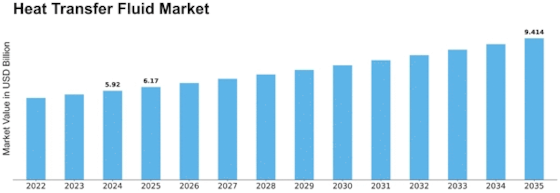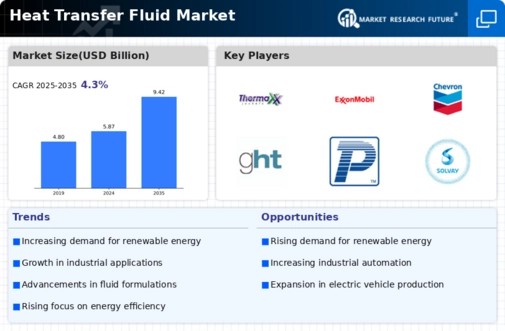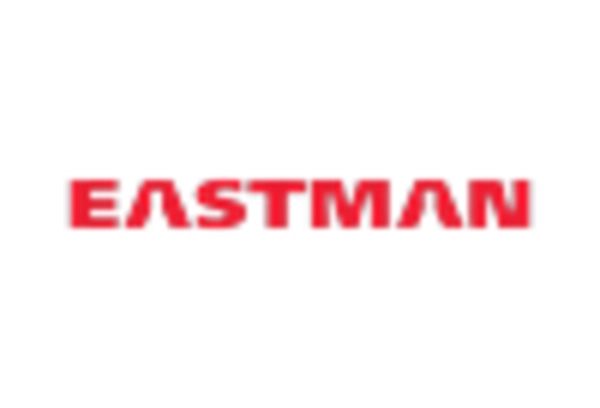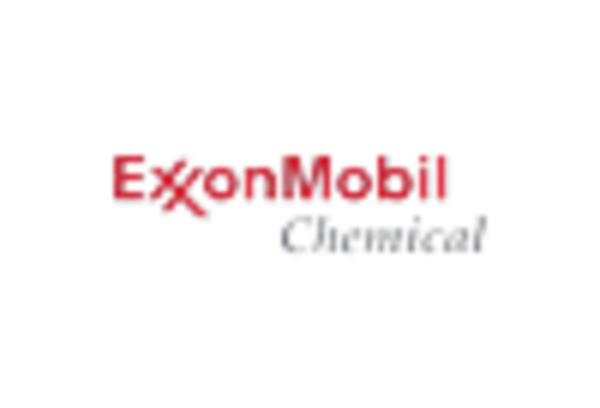Heat Transfer Fluid Size
Heat Transfer Fluid Market Growth Projections and Opportunities
The heat transfer fluid market is influenced by various market factors that collectively shape the supply and demand for these essential fluids used in diverse industrial applications. One prominent factor is the increasing emphasis on energy efficiency across industries. As companies strive to optimize their processes, heat transfer fluids play a crucial role in maintaining consistent temperatures in various equipment, enhancing overall energy efficiency. The demand for heat transfer fluids is particularly pronounced in industries such as manufacturing, energy generation, and chemical processing, where precise temperature control is essential for operational efficiency.
Renewable energy sources contribute significantly to the market factors influencing the heat transfer fluid industry. Solar thermal systems, geothermal power plants, and biomass facilities rely on heat transfer fluids to capture and transfer thermal energy efficiently. As the global shift towards renewable energy sources gains momentum, the demand for heat transfer fluids compatible with these technologies is on the rise. Manufacturers need to tailor their products to meet the specific requirements of renewable energy applications, such as high-temperature stability and environmental compatibility, to tap into this growing market.
Technological advancements represent a critical market factor shaping the heat transfer fluid industry. Ongoing research and development efforts focus on enhancing the performance and sustainability of these fluids. New formulations with improved thermal conductivity, stability, and extended life cycles are introduced to meet the evolving needs of various industrial processes. Nanotechnology has also made significant contributions, leading to the development of nanofluids with superior thermal properties. The integration of advanced technologies continues to be a driving force in the competitiveness of heat transfer fluid products.
Regulatory standards and environmental considerations are key market factors that manufacturers must navigate. Adherence to safety and environmental regulations is not only a legal requirement but also a market differentiator. Heat transfer fluids that comply with stringent standards gain credibility and trust in the market. As environmental concerns grow, there is an increasing focus on developing heat transfer fluids with reduced environmental impact, low toxicity, and improved biodegradability, aligning with global sustainability goals.
Economic factors play a significant role in influencing market dynamics. Economic downturns can lead to reduced industrial activities and, consequently, a decline in the demand for heat transfer fluids. Conversely, economic growth, industrialization, and infrastructure development create opportunities for market expansion. Manufacturers must stay vigilant and adaptable to economic fluctuations across different regions to navigate these market factors successfully.
The competitive landscape is another critical market factor shaping the heat transfer fluid industry. Established players, new entrants, and regional competitors collectively contribute to a dynamic market environment. Strategic collaborations, mergers, and acquisitions are common strategies employed by companies to strengthen their market positions, expand their product portfolios, and enhance their global reach. Customer relationships, technical support, and value-added services become crucial elements for manufacturers aiming to differentiate themselves in a competitive market.
Market factors are also influenced by the globalization of industries. As companies expand their operations globally, the demand for standardized and reliable heat transfer fluid solutions increases. Manufacturers need to align their products with international standards and cater to the diverse requirements of a global customer base. Understanding regional preferences, regulatory landscapes, and industry-specific needs becomes essential for sustained success in the global heat transfer fluid market.
the heat transfer fluid market is influenced by a combination of factors, including the growing emphasis on energy efficiency, the impact of renewable energy sources, technological advancements, regulatory standards, economic conditions, and the dynamics of global competition. Manufacturers in this industry must remain agile, innovative, and responsive to these market factors to capitalize on emerging opportunities, meet evolving customer demands, and maintain a competitive edge in the dynamic landscape of heat transfer fluid solutions.


















Leave a Comment